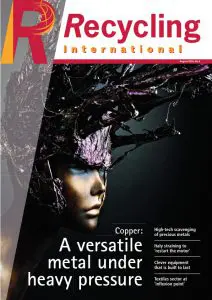Page 15 from: August 2015

15August 2014
The good thing about copper is that it is one of the few materials that can be recycled
over and over again without degrading or los-
ing its chemical or physical properties. In addi-
tion, over the past decade, the price of copper
scrap has been rising almost constantly, and so
has demand. Last year, scrap contributed 37%
or more than 10 million tonnes of the total
copper consumption of nearly 27 million
tonnes, according to the UK-based metal mar-
kets research bureau Wood Mackenzie.
However, with the downturn in copper scrap
prices since January this year, recyclers have
been facing greater challenges to their profit-
ability. And despite signs that prices could
improve again over the coming months and
that global economic growth will sooner or
later boost red metal demand, these provide
absolutely no guarantee of better times ahead.
Indeed, speakers at Metal Bulletin’s third Cop-
per Recycling Conference, held recently in the
Swedish capital Stockholm, used this stage to
ring the alarm bells.
Facing certain uncertainty
According to Norbert Zonneveld, executive
secretary of the European Electronics Recyclers
Association (EERA), there is deep and growing
concern among the organisation’s members.
Zonneveld pointed to the complexity of elec-
tronic products and to an increase in impuri-
ties, thus making it more and more compli-
cated for recyclers to extract valuable materials.
´When you look at the number of elements
used in the electrical and electronics industry
100 years ago and you compare it to the situa-
tion nowadays, you see that there has been an
enormous growth in elements used,’ he said.
‘With this complexity being so enormous, you
really ask yourself “How, for goodness sake, do
we get all the elements out, and at what cost?”’
On the cost issue, Zonneveld underlined the
‘increased difficulty’ presented by the shorter
lifecycles of electronic devices. ‘What we now see
is that, in ten years’ time, new systems such as
LCD fade in and fade out. And we as recyclers are
challenged to both develop innovative processes
and make sure the money invested is earned back
by the time new devices enter the market.’
At the end of the day, ‘earnings for the industry
will be lower because of higher investments’,
Zonneveld argued. ‘Obviously, shorter lifecycles
put an enormous pressure on investments.’
This has led to a largely ‘uncertain’ situation.
‘But what we do know for certain is that the
copper price won’t go up in the future as it has
during the last decade,’ he insisted. In the long-
er term, therefore, e-scrap recycling in general
could become ‘an unattractive industry in
which to invest when return on investment is
not guaranteed’, he warned.
Need to talk more
EERA’s executive secretary also noted that the
greater complexity of devices and rising mate-
rial extraction costs were not compensated by
the recovered copper given that ‘copper vol-
umes in devices are reducing as well’. And he
added: ‘Some devices only hold 4% copper.’
This trend is developing at a faster rate than we
might think, revealed Helena Castren, now the
senior sustainability officer at Microsoft Fin-
land after having recently left the same position
at Finnish mobile phone manufacturer Nokia.
Comparing a 2006 Nokia phone with one from
2012, she pointed out that, in the space of six
years, the copper content had fallen from 19%
to 9%. Such developments had a massive
impact given that, worldwide, ‘there are some
6 billion mobile devices’, she noted.
She warned delegates in Stockholm to be pre-
pared for challenging times as ‘a complex mix-
ture of complex materials’ was heading for their
processing facilities. This complexity, she
added, ‘threatens recyclability’ and makes the
need for progress on design for recycling ‘more
urgent than ever’. To achieve this, she believes,
‘we should be talking more to each other in this
business, something we are not really doing
now’. Recycling was the responsibility of both
producers and recyclers, she emphasised.
Urban mining frontrunner
The topic of increased levels of complexity and
impurity was also pursued by Olov Boman,
secondary raw materials manager at Swedish
metals major Boliden. ’We see more and more
Substitution to reduce
scrap supply – but also
demand
Two fundamental factors determine the genera-
tion of scrap, delegates in Stockholm were
informed by Wood Mackenzie’s copper market
research specialist Ian Littlewood: ‘Firstly, eco-
nomic activity which produces scrap, and sec-
ondly, the price of copper which drives the incen-
tive to collect that scrap which is generated.’
Price is the stronger of these two factors, he point-
ed out, adding that ‘the volatility of the copper
price results in the volatility of scrap generation’.
Wood Mackenzie has forecast that scrap gen-
eration will increase by 0.2% in 2014, with an
upturn in generation of new scrap (clippings,
turnings and shavings left over from the fabrica-
tion process) offsetting a decline in old scrap
owing to the current relatively low prices com-
pared to recent years. Littlewood added: ‘Scrap
markets have been very tight this year and this
resulted in scrap trade declining by around 5%
in the first quarter of 2014.’
In the longer term, the analyst expected that
substitution would
reduce not only the
supply of scrap but also
demand. ‘On balance,’
he concluded, ‘there
will be more scrap avail-
able for secondary cop-
per producers.’
‘Don’t expect
Russia to just give
away the scrap.’
Norbert Zonneveld: ‘How, for
goodness sake, do we get all the
elements out?’
Marcus Kartenbeck: ‘Don’t over-
estimate growth of copper
demand from China.’
Helena Castren: be prepared for
‘a complex mixture of complex
materials’.
Olov Boman: ‘We could clean up
Sweden’s mobile phone moun-
tain in less than six days.’
Ian Littlewood.
RI-6 copper feature2.indd 15 04-08-14 09:39



